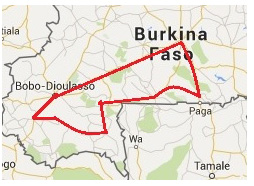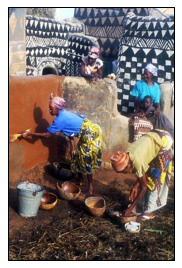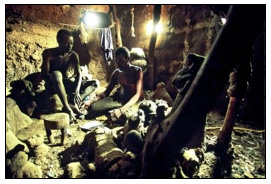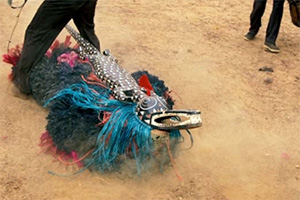Tour to Burkina Faso: Tribal Art
 Highlights:
Highlights:
A fantastic cultural journey to meet the populations of Burkina Faso who still live following their ancestral traditions:
- The Gurunsi women who paint beautiful frescoes on the walls of their houses; the Lobi who still build fortified homes.
- The Bwa who dance dressed up in spectacular flat masks up to two meters high.
- The visit of Bobo-Dioulasso with its colonial past is also a must.
For travelers who like cultural and tribal journeys in Africa.
| Day 1 | Arrival in Ouagadougou (Burkina Faso) and transfer to the hotel. |
| Day 2 | Sahelian town, from Ouagadougou to Po |
| Day 3 | African frescoes, from Po to Leo |
| Day 4 | Fortified villages, from Leo to Gaoua |
| Day 5 | Traditional Chiefs, Gaoua region |
| Day 6 | Rocky domes, from Gaoua to Banfora |
| Day 7 | Bobo Dioulasso, from Banfora to Bobo |
| Day 8 | Bwaba masks, from Bobo to Ouagadougou |
| Day 9 | Village museum, from Ouagadougou to Manega and back to Ouagadougou. Departure. |
Detailed Itinerary
Day 1: Ouagadougou
Arrival in Ouagadougou (Burkina Faso) and transfer to the hotel. Free time to relax.
Meals: own arrangements
Overnight: Hotel Le Grand Calao or similar (all rooms ensuite and with aircon)
Day 2: Sahelian town, from Ouagadougou to Po (150 km – 3 hr)
Ouagadougou, the capital of Burkina Faso, lies in the middle of West African savannah. Life happens in and around the streets, in a unique fusion of village and town ambiances: old taxis, bicycles, scooters, donkeys pulling chariots, porters carrying big loads on the heads, traders selling colorful goods, small open air restaurants with loud music, chickens and goats everywhere eating spilled food, a colorful hand-painted board advertising a local «coiffeur» in the shade of a mango tree etc. In street markets colors are brilliant and smells very strong. In the suburb there is a large area dedicated to the exhibition of the craftsmen’s work, a great opportunity to appreciate artists’ skills and the beauty of African craftworks.
In the afternoon departure southwards.
Meals: B - L - D
Overnight: Hotel Envol or similar (all rooms ensuite and with aircon)
Day 3: African frescoes, from Po to Leo (190 km – 4 hr)
 In the southern Savannah we meet with the Gurunsi tribe living in adobe fortified buildings decorated with amazing black, red and white African frescoes. Their society is organized around gender: men are in charge of constructions while women take care of painting and decorating, using natural colours on an okra background. Men build houses by putting different layers of clay over support pillars and arches, walls and terraces are then made waterproof by spreading a mixture with zebu dung. It is at this point that women take over and paint amazingly beautiful and intricate frescoes. An excellent example of African art where architecture and painting merge and give life to a “fluid” masterpiece, the kind of sculptural architecture that highly influenced the work of Le Corbusier. And the only way to really understand and appreciate the intense beauty of this art-work is to see it first hand.
Continuation to Leo, visiting villages on the way.
In the southern Savannah we meet with the Gurunsi tribe living in adobe fortified buildings decorated with amazing black, red and white African frescoes. Their society is organized around gender: men are in charge of constructions while women take care of painting and decorating, using natural colours on an okra background. Men build houses by putting different layers of clay over support pillars and arches, walls and terraces are then made waterproof by spreading a mixture with zebu dung. It is at this point that women take over and paint amazingly beautiful and intricate frescoes. An excellent example of African art where architecture and painting merge and give life to a “fluid” masterpiece, the kind of sculptural architecture that highly influenced the work of Le Corbusier. And the only way to really understand and appreciate the intense beauty of this art-work is to see it first hand.
Continuation to Leo, visiting villages on the way.
Meals: B - L - D
Overnight: Auberge de la Sissili or similar (all rooms ensuite and with aircon)
Day 4: Fortified villages, from Leo to Gaoua (250 km – 5 hr)
 Day dedicated to the exploration of a region rarely visited by tourists. Here we meet with the Dagarti people who share the same environment with the Lobi and just like them they build fortified houses. Still today they keep strong ties to the invisible world of Spirits, represented by fetishes, altars and sacred sites.
Day dedicated to the exploration of a region rarely visited by tourists. Here we meet with the Dagarti people who share the same environment with the Lobi and just like them they build fortified houses. Still today they keep strong ties to the invisible world of Spirits, represented by fetishes, altars and sacred sites.
In the afternoon visit of some Lobi villages. The Lobi of Burkina are the shiest members of this tribe who has spread throughout Burkina Faso, Ghana and the Ivory Coast. Here in Burkina they also appear to have the most characteristic villages - probably their shy behaviour has helped them keep their traditions more intact. Each family lives in a big fortified building made out of clay and they carve wooden statues for the cult of their ancestors. Men still move around armed with bows and arrows while old women may wear a small disc on the lower lip. During our visit we will be accompanied by a guide speaking the Lobi dialect and this will enable us to overcome their innate distrust and make us welcomed.
Meals: B - L - D
Overnight: Hotel Hala or similar (all rooms ensuite and with aircon)
Day 5: Traditional Chiefs, Gaoua region (150 km – 4 hr)
We continue our visit of the Lobi fortified villages and also stop at Loropeni Ruins, a “mysterious” place. Loropéni figures on the UNESCO World Heritage List and covers an area of 10 sqkm. Its array of stone walls is one of the best preserved examples of fortified settlement in West Africa and it probably dates back to many centuries, when gold mining was at its peak. At Obire we will possibly meet with the traditional Chief of the Gan Dynasty and his court - a great opportunity to personally ask questions on the role of traditional chiefs in modern Africa. The Gan live in polygamous compound groups: a man and his wives live around a courtyard together, the man in a rectangular hut while each wife in her own circular house.
Meals: B - L - D
Overnight: Hotel Hala or similar (all rooms ensuite and with aircon)
Day 6: Rocky domes, from Gaoua to Banfora (220 km – 5 hr)
On the way to Banfora, along the road, we shall meet communities of gold miners, who, even nowadays, still dig deep tunnels in search for the precious mineral. The region of Banfora is so rich of surprises. Across vast sugar cane plantations, we reach the “Les Domes de Fadébougou”, a location where millennia of water and wind erosion have given rocks the shape of a dome overlooking the plain. And from the top we will enjoy a beautiful panorama. We then continue to Kerfiéguela Waterfalls to have the opportunity to jump into the water and freshen up, always enjoyable when surrounded by arid savannah.
Meals: B - L - D
Overnight: Hotel Canne à Sucre or similar (all rooms ensuite and with aircon)
Day 7: Bobo Dioulasso, from Banfora to Bobo (150 km – 3 hr)
We drive to Bobo Dioulasso.
Bobo Dioulasso, the second largest city in Burkina after Ouagadougou, is a charming African city, certainly the greenest in the country. Many of its neighbourhoods have maintained a peculiar colonial atmosphere while the train station was built in Neo-Moorish style. In a radically different style is the mosque, built in purely Sudanese style in 1880 or 1893. Despite being a big city, life here still moves at a slow pace and the rich diversity of its inhabitants creates a unique charme.
In 1891, French explorer Crozat used these words to describe the importance of trade in Bobo Dioulasso: “the caravans coming from the South bring cola nuts and fabric; the Northern ones come loaded with salt; iron tools and glass beads come from the East while Gold arrives from Lobi country”.
Free time to visit some antique shops which offer wonderful wooden masks in the most diverse shapes: butterflies, owls, alligators etc.
Meals: B - L - D
Overnight: L’Auberge or similar (all rooms ensuite and with aircon)
Day 8: Bwaba masks, from Bobo to Ouagadougou (360 km – 6 hr)
 Departure early in the morning for a long drive back to the capital city. In a small village we assist to an incredible performance of the Bobo-Bwa masks. These wooden masks represent different characters related to the myths of their families and clans. They embody the spirits of the village, ancestors and Mother Nature. Some stand for animals while others represent bush spirits. The “plank masks”, with a styled face topped by a tall rectangular plank, are very impressive and tend to be painted on both sides with awesome geometrical patterns. Like all masks of the Volta region, also the Bwa ones are chromatic with white, red and black as predominant colors. Everybody puts on the best traditional outfit for the ceremony and, in the middle of the village, waits for the masks. It is “the” event. All of a sudden drums announce the dance and Spirits arrive in many shapes. Movements are fast, following the rhythm of drums and flutes. The audience participates in the ceremony with their songs, comments and laughs. It is a form of street theatre that puts together sacred ancestral traditions and cheerful entertainment.
Departure early in the morning for a long drive back to the capital city. In a small village we assist to an incredible performance of the Bobo-Bwa masks. These wooden masks represent different characters related to the myths of their families and clans. They embody the spirits of the village, ancestors and Mother Nature. Some stand for animals while others represent bush spirits. The “plank masks”, with a styled face topped by a tall rectangular plank, are very impressive and tend to be painted on both sides with awesome geometrical patterns. Like all masks of the Volta region, also the Bwa ones are chromatic with white, red and black as predominant colors. Everybody puts on the best traditional outfit for the ceremony and, in the middle of the village, waits for the masks. It is “the” event. All of a sudden drums announce the dance and Spirits arrive in many shapes. Movements are fast, following the rhythm of drums and flutes. The audience participates in the ceremony with their songs, comments and laughs. It is a form of street theatre that puts together sacred ancestral traditions and cheerful entertainment.
The Bwa of Burkina Faso are the farmers of the savannah and most of them have remained faithful to their traditional religion where masks are regularly used to celebrate their myths. Their society is also divided into specific corporations: peasants, blacksmiths and “griots” (term indicating “story-tellers”, those who have the task to tell the events of the past, to recount history).
In the afternoon arrival in Ouagadougou.
Meals: B - L - D
Overnight: Hotel Le Grand Calao or similar (all rooms ensuite and with aircon)
Day 9: Village museum, from Ouagadougou to Manega and back to Ouagadougou (130 km – 3 hr)
Manega museum : one of the best museums in West Africa. A cultural landmark created by the lawyer-poet Frédéric Pacéré Titinga with the goal to re-situate African art in the natural context of village life.
In the afternoon free time for last purchases in the “Village Artisanal” and in the evening transfer to the airport for the flight out.
Meals: B - L
Day-use: Rooms in day-use till 18.00 hrs (all rooms ensuite and with aircon)
Day 1: Hotel Le Grand Calao or similar, |
|
Day 2: Hotel Envol or similar, |
|
Day 3: Auberge de la Sissili or similar, |
|
Day 4, 5: Hotel Hala or similar, |
|
Day 6: Hotel Canne à Sucre or similar, |
|
Day 7: L’Auberge or similar, |
|
Day 8: Hotel Le Grand Calao or similar, |




